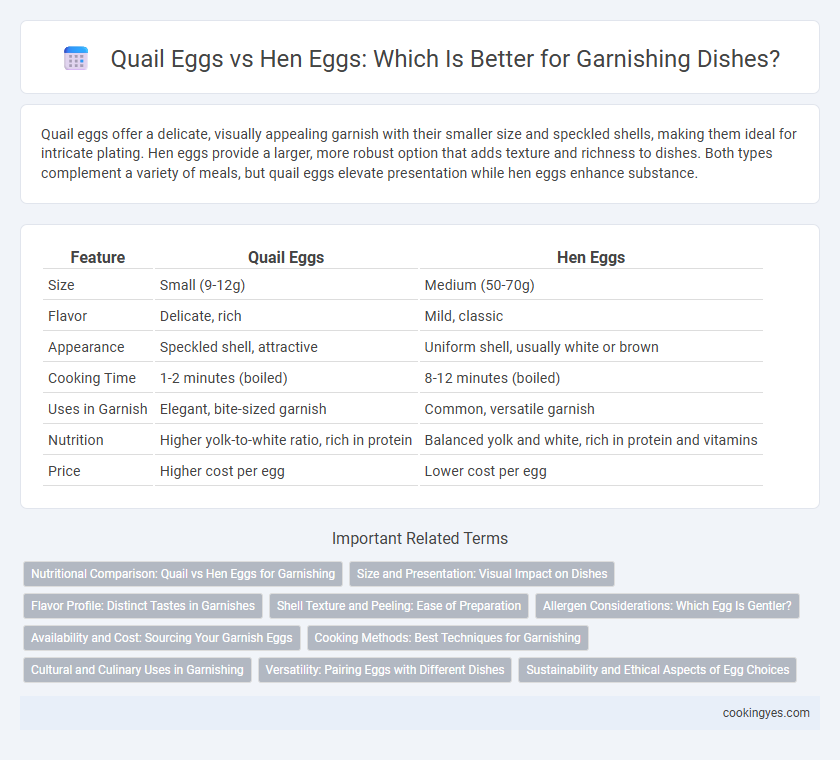Quail eggs offer a delicate, visually appealing garnish with their smaller size and speckled shells, making them ideal for intricate plating. Hen eggs provide a larger, more robust option that adds texture and richness to dishes. Both types complement a variety of meals, but quail eggs elevate presentation while hen eggs enhance substance.
Table of Comparison
| Feature | Quail Eggs | Hen Eggs |
|---|---|---|
| Size | Small (9-12g) | Medium (50-70g) |
| Flavor | Delicate, rich | Mild, classic |
| Appearance | Speckled shell, attractive | Uniform shell, usually white or brown |
| Cooking Time | 1-2 minutes (boiled) | 8-12 minutes (boiled) |
| Uses in Garnish | Elegant, bite-sized garnish | Common, versatile garnish |
| Nutrition | Higher yolk-to-white ratio, rich in protein | Balanced yolk and white, rich in protein and vitamins |
| Price | Higher cost per egg | Lower cost per egg |
Nutritional Comparison: Quail vs Hen Eggs for Garnishing
Quail eggs contain higher levels of vitamin B12, iron, and phosphorus compared to hen eggs, making them a nutrient-dense option for garnishing. While hen eggs provide more protein and slightly fewer calories, quail eggs offer concentrated nutrients in smaller portions ideal for delicate presentation. Both varieties add unique flavors, but quail eggs stand out for their rich micronutrient profile in garnishing dishes.
Size and Presentation: Visual Impact on Dishes
Quail eggs, significantly smaller than hen eggs, offer a delicate and refined visual element that enhances dish presentation with their petite size and distinctive speckled shells. Hen eggs, larger and more uniform, provide a bolder garnish, suitable for creating more substantial, visually striking accents on plates. The size contrast between quail and hen eggs allows chefs to tailor the garnish's impact, using quail eggs for elegance and subtlety, while hen eggs contribute to a more prominent presentation.
Flavor Profile: Distinct Tastes in Garnishes
Quail eggs offer a rich, slightly gamey flavor with a creamy texture that enhances the visual appeal and complexity of garnishes. Hen eggs have a milder, more familiar taste, making them a versatile choice for a wide range of dishes. Using quail eggs for garnish creates a sophisticated taste contrast, while hen eggs provide a classic, subtle flavor base.
Shell Texture and Peeling: Ease of Preparation
Quail eggs have a delicate, thinner shell that often makes peeling more challenging but results in a smoother, more refined garnish surface. Hen eggs feature a thicker, sturdier shell that generally peels more easily, allowing for quicker preparation and a rustic texture. This difference in shell texture and peeling ease impacts the presentation and efficiency of using quail or hen eggs as garnish.
Allergen Considerations: Which Egg Is Gentler?
Quail eggs are generally considered gentler for individuals with mild egg allergies due to their different protein structure compared to hen eggs, which may cause fewer allergic reactions. Hen eggs contain ovomucoid, a dominant allergen that often triggers sensitivities, whereas quail eggs have lower levels of this protein. Despite this, consulting an allergist before substituting quail eggs for garnish is essential, as cross-reactivity can still occur in some allergic individuals.
Availability and Cost: Sourcing Your Garnish Eggs
Quail eggs are smaller and less widely available than hen eggs, often requiring specialty suppliers or gourmet stores, which impacts their cost and accessibility for garnishing dishes. Hen eggs are more abundant and affordable, making them the preferred choice for most kitchens due to consistent supply and budget-friendliness. Choosing between quail and hen eggs for garnish depends on desired presentation and cost constraints, with quail eggs typically commanding a higher price due to limited availability.
Cooking Methods: Best Techniques for Garnishing
Quail eggs, smaller and more delicate than hen eggs, are ideal for boiling or frying briefly to maintain their tender texture, making them perfect for garnishing salads and appetizers. Hen eggs offer more versatility with poaching, scrambling, or creating decorative slices, providing a richer flavor profile and sturdier structure for elaborate garnishes. Using precise cooking techniques like soft boiling for quail eggs preserves their distinct yolk, while firm boiling hen eggs ensures clean cuts for elegant presentation.
Cultural and Culinary Uses in Garnishing
Quail eggs are prized in Japanese and French cuisine for their delicate size and rich flavor, often used as an elegant garnish on sushi and haute dishes. Hen eggs, being larger and more common, serve as a versatile garnish in Western salads, deviled eggs, and breakfast plates. The distinct appearance and texture of quail eggs add a refined visual and taste element, while hen eggs offer familiar comfort and bulk to garnished dishes.
Versatility: Pairing Eggs with Different Dishes
Quail eggs offer a unique, delicate flavor and are prized for their small size, making them ideal for elegant garnishes on salads, canapes, and sushi. Hen eggs provide a more substantial texture and richer taste, complementing a wide range of dishes from breakfast bowls to hearty casseroles. Both types of eggs enhance versatility in pairing, with quail eggs adding visual appeal and a subtle taste, while hen eggs deliver classic richness and robust flavor.
Sustainability and Ethical Aspects of Egg Choices
Quail eggs offer a more sustainable option for garnishing due to their smaller size and lower resource consumption compared to hen eggs, reducing environmental impact in production. Ethically, quail farming often involves less intensive practices and shorter breeding cycles, potentially enhancing animal welfare standards. Choosing quail eggs supports sustainable culinary practices while aligning with growing consumer demand for ethically sourced ingredients.
Quail eggs vs Hen eggs for garnish Infographic

 cookingyes.com
cookingyes.com